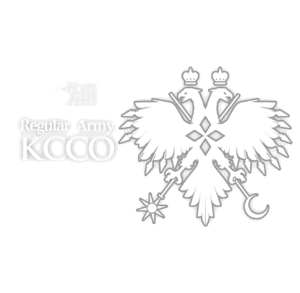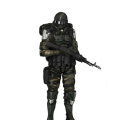KCCO: Difference between revisions
Add some information, trivia, and history. |
StormTetris (talk | contribs) Updated the KCCO doggo name to actual in-game name. |
||
| (11 intermediate revisions by 3 users not shown) | |||
| Line 1: | Line 1: | ||
[[File:KCCO Logo EN.png|300px|frameless|right]] | |||
[[File: | The '''[[wikipedia:Special Operations Forces (Russia)|Special Operations Forces Command]]'''<ref>[[wikipedia:General Staff of the Armed Forces of the Russian Federation#General Staff organization|Wikipedia entry on the KSSO]]</ref> (特种作战司令部, Командование сил специальных операций; abbreviated КССО in Cyrillic script and KSSO or KSO in transliterated Latin script), or the '''Regular Army''' (正规军 in Chinese, Korean, and Japanese), was a [[wikipedia:Russia|Russian]], later [[Soviet Union|Neo-Soviet]] strategic-level special forces command and a subbranch of the Neo-Soviet Army, and later turned rogue military force. Originally a supporting faction, they quickly became the second antagonistic faction of [[Girls' Frontline]]. The KCCO's true objective was to tear up the peace treaty between the Neo-Soviet Union and the [[Pan-European Union]], to reignite [[World War Three]] and make the Neo-Soviet Union the final victor of the war. Their plan was foiled by the [[Soviet Union#Bureau of State Security|Bureau of State Security]] and [[Griffin & Kryuger]]. | ||
The '''[[wikipedia:Special Operations Forces (Russia)|Special Operations Forces Command]]'''<ref>[ | |||
Under [[General Carter]]'s command, the KCCO | The KCCO's special forces branch, the '''Special Operations Forces''' (Силы специальных операций; abbreviated SOF in English script, ССО in Cyrillic script, and SSO in transliterated Latin script), were a highly mobile, well-trained and equipped, rapid-response special operations force of the [[wikipedia:Ministry of Defence (Russia)|Ministry of Defence]], capable of military operations both within the country and abroad, in peacetime and in wartime. The Russian Ministry of Defence defined the term "special operation" as "methods and ways of fighting not characteristic of conventional forces: reconnaissance and sabotage, subversion and sedition, counter-terrorism, counter-sabotage, counterintelligence, guerrilla, counter-guerrilla and other activities". Under [[General Carter]]'s command, the KCCO employed highly trained human veterans, most of which survived World War Three, as well as military-grade [[Automaton|Automata]], drones, vehicles, and mechs. In fact, the KCCO deploys their mechanical units more frequently than their human operators, which is why [[the Commander]] and Griffin's [[Tactical Doll|T-Dolls]] mostly encountered the KCCO's mechanical units (KCCO [[Automaton|automatons]] do not embark a [[Neural Cloud]] and are thus not classified as Dolls). | ||
==Story== | ==Story== | ||
===Origins=== | ===Origins=== | ||
''Main article: [https://en.wikipedia.org/wiki/ | ''Main article: [[wikipedia:Special Operations Forces (Russia)#History|Special Operations Forces' History]]'' | ||
In 2009, as a part of the comprehensive reform of the [[wikipedia:Russian Armed Forces|Russian Armed Forces]], the Special Operations Directorate, subordinate directly to the [[Chief of the General Staff, was created on the basis of the [https://en.wikipedia.org/wiki/GRU GRU] in the Moscow Oblast and saw extensive action in the Caucasus region and in Syria. In 2012, the Special Operations Directorate was reorganized as Special Operations Command, or KCCO, and plans were made to upscale the Forces to nine special purpose brigades. | |||
After the rise of the Neo-Soviet Union in 2032, the KCCO still served as its special forces command. | |||
===World War Three=== | ===World War Three=== | ||
When | When World War Three began, the KCCO fought against the Western nations in Europe and the [[United States]]. At the close of the war, the factions had expended all their resources and were forced to sign a peace treaty. This greatly upset some within the KCCO, including General Carter, Captain [[Yegor]] and their soldiers, as they wanted the Neo-Soviet Union to be the clear winner of the war. Before the war, Carter had an encounter with [[Relic Technology]] at OKb-413, and with the help of [[William]], he used this knowledge to form a plan to re-start the war. | ||
===Sangvis Ferri HQ joint assault=== | ===Sangvis Ferri HQ joint assault=== | ||
In 2064, the KCCO organized a joint assault with the PMC | {{Incomplete|reason=story after Chapter 10}} | ||
In 2064, the KCCO organized a joint assault with the PMC Griffin & Kryuger to destroy the [[Sangvis Ferri]] HQ and put an end to the rebellion of the SF T-Dolls. The operation was actually a ploy by the KCCO to arrange an encounter between the Sangvis Mastermind {{enemy name|Elisa|boss}} and the [[AR Team]] T-Doll {{doll name|M4A1|AR|4}}, which William believed would create an entity able to reactivate Relics, breaking the [[Relic Arms Limitation Treaty]] and providing the West a casus belli to restart the war. | |||
==Members== | ==Members== | ||
| Line 39: | Line 32: | ||
===Standard units=== | ===Standard units=== | ||
* | *Humanoid automatons | ||
**{{enemy name|Cyclops}} | **{{enemy name|Cyclops}} | ||
**{{enemy name|Cyclops (SG)}} | |||
**{{enemy name|Cyclops (MG)}} | |||
**{{enemy name|Aegis (KCCO)}} | **{{enemy name|Aegis (KCCO)}} | ||
**{{enemy name|Aegis (KCCO SWAP)}} | |||
**{{enemy name|Archer}} | **{{enemy name|Archer}} | ||
*Robots and drones | *Robots and drones | ||
**{{enemy name|Dactyl}} | **{{enemy name|Dactyl}} | ||
**{{enemy name|Cerynitis}} | **{{enemy name|Cerynitis}} | ||
**{{enemy name|Cerynitis (SWAP)}} | |||
**{{enemy name|Hydra}} | **{{enemy name|Hydra}} | ||
**{{enemy name|Pathfinder}} | **{{enemy name|Pathfinder}} | ||
**{{enemy name| | **{{enemy name|Orthros}} | ||
*Vehicles | *Vehicles | ||
**{{enemy name|Typhon}} | **{{enemy name|Typhon}} | ||
**{{enemy name|Coeus}} | **{{enemy name|Coeus}} | ||
*Mechs | *Mechs | ||
**{{enemy name| | **{{enemy name|Minotaurus}} | ||
**{{enemy name|Kratos}} | **{{enemy name|Kratos}} | ||
**{{enemy name|Lycaon}} | |||
**{{enemy name|Ares|boss}} | **{{enemy name|Ares|boss}} | ||
*Other units | *Other units | ||
| Line 63: | Line 61: | ||
<gallery> | <gallery> | ||
File:Character_Profile_Yegor_Armored3.png|Artwork of a KCCO human operator. | File:Character_Profile_Yegor_Armored3.png|Artwork of a KCCO human operator. | ||
File:KCCO_Logo.png|CN logo. | |||
</gallery> | </gallery> | ||
==Trivia== | ==Trivia== | ||
*The helmet that KCCO human | *KCCO field units are named after gemstones and mineral species, such as amber, hematite, quartz, zircon,<ref>{{cite|gfl|pl|Annealing II}}</ref> scheelite or chlorite.<ref>{{cite|gfl|ls|E25}}</ref> | ||
*The helmet that KCCO human operatives wear in their artwork seems to be the Altyn helmet. Although this helmet is popular among Russian special forces and intelligence agencies like the [[wikipedia:Federal Security Service|Federal Security Service]] (FSB), there are no evidence of the [[wikipedia:Special Operations Forces (Russia)|Special Operations Forces]] using the Altyn. It is quite weird anyway to see future special forces using a 1984 helmet, especially given the advanced technology used by the KCCO. | |||
==Reference== | ==Reference== | ||
Latest revision as of 07:24, 8 December 2023

The Special Operations Forces Command[1] (特种作战司令部, Командование сил специальных операций; abbreviated КССО in Cyrillic script and KSSO or KSO in transliterated Latin script), or the Regular Army (正规军 in Chinese, Korean, and Japanese), was a Russian, later Neo-Soviet strategic-level special forces command and a subbranch of the Neo-Soviet Army, and later turned rogue military force. Originally a supporting faction, they quickly became the second antagonistic faction of Girls' Frontline. The KCCO's true objective was to tear up the peace treaty between the Neo-Soviet Union and the Pan-European Union, to reignite World War Three and make the Neo-Soviet Union the final victor of the war. Their plan was foiled by the Bureau of State Security and Griffin & Kryuger.
The KCCO's special forces branch, the Special Operations Forces (Силы специальных операций; abbreviated SOF in English script, ССО in Cyrillic script, and SSO in transliterated Latin script), were a highly mobile, well-trained and equipped, rapid-response special operations force of the Ministry of Defence, capable of military operations both within the country and abroad, in peacetime and in wartime. The Russian Ministry of Defence defined the term "special operation" as "methods and ways of fighting not characteristic of conventional forces: reconnaissance and sabotage, subversion and sedition, counter-terrorism, counter-sabotage, counterintelligence, guerrilla, counter-guerrilla and other activities". Under General Carter's command, the KCCO employed highly trained human veterans, most of which survived World War Three, as well as military-grade Automata, drones, vehicles, and mechs. In fact, the KCCO deploys their mechanical units more frequently than their human operators, which is why the Commander and Griffin's T-Dolls mostly encountered the KCCO's mechanical units (KCCO automatons do not embark a Neural Cloud and are thus not classified as Dolls).
Story[edit]
Origins[edit]
Main article: Special Operations Forces' History
In 2009, as a part of the comprehensive reform of the Russian Armed Forces, the Special Operations Directorate, subordinate directly to the [[Chief of the General Staff, was created on the basis of the GRU in the Moscow Oblast and saw extensive action in the Caucasus region and in Syria. In 2012, the Special Operations Directorate was reorganized as Special Operations Command, or KCCO, and plans were made to upscale the Forces to nine special purpose brigades.
After the rise of the Neo-Soviet Union in 2032, the KCCO still served as its special forces command.
World War Three[edit]
When World War Three began, the KCCO fought against the Western nations in Europe and the United States. At the close of the war, the factions had expended all their resources and were forced to sign a peace treaty. This greatly upset some within the KCCO, including General Carter, Captain Yegor and their soldiers, as they wanted the Neo-Soviet Union to be the clear winner of the war. Before the war, Carter had an encounter with Relic Technology at OKb-413, and with the help of William, he used this knowledge to form a plan to re-start the war.
Sangvis Ferri HQ joint assault[edit]
In 2064, the KCCO organized a joint assault with the PMC Griffin & Kryuger to destroy the Sangvis Ferri HQ and put an end to the rebellion of the SF T-Dolls. The operation was actually a ploy by the KCCO to arrange an encounter between the Sangvis Mastermind Elisa and the AR Team T-Doll AR M4A1M4A1M4A1, which William believed would create an entity able to reactivate Relics, breaking the Relic Arms Limitation Treaty and providing the West a casus belli to restart the war.
Members[edit]
- Carter Neustald (leader)
- Yegor (second-in-command)
Units[edit]
Argo armored trains[edit]
Argo armored trains are the gigantic armored trains of KCCO that use to support their battle, which have 3 trains:
- Argo-Carina (mortar)
- Argo-Vela (laser cannon, later stolen by Griffin's T-Dolls)
- Argo-Puppis (cannon)
Standard units[edit]
- Humanoid automatons
- Robots and drones
- Vehicles
- Mechs
- Other units
- Recce Centre (Pathfinder building factories)
- Acheron (repair stations)
Gallery[edit]
-
Artwork of a KCCO human operator.
-
CN logo.
Trivia[edit]
- KCCO field units are named after gemstones and mineral species, such as amber, hematite, quartz, zircon,[2] scheelite or chlorite.[3]
- The helmet that KCCO human operatives wear in their artwork seems to be the Altyn helmet. Although this helmet is popular among Russian special forces and intelligence agencies like the Federal Security Service (FSB), there are no evidence of the Special Operations Forces using the Altyn. It is quite weird anyway to see future special forces using a 1984 helmet, especially given the advanced technology used by the KCCO.
Reference[edit]
- ↑ Wikipedia entry on the KSSO
- ↑ Girls' Frontline, Polarized Light, Annealing II
- ↑ Girls' Frontline, Longitudinal Strain, E25
| Lore topics |
|---|



